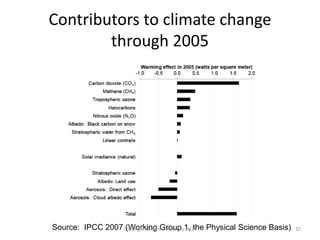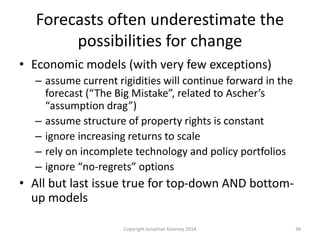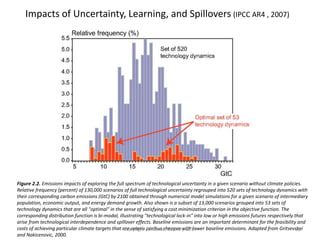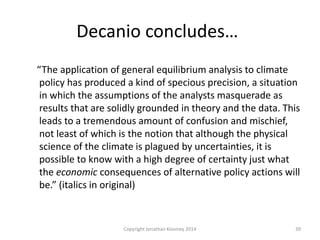The document discusses the significant risks posed by climate change, emphasizing human responsibility for its acceleration and the urgent need for action. It explores various strategies for addressing climate change, including adaptation, mitigation, and the necessity for rapid innovation and implementation of low-carbon technologies. Ultimately, it advocates for a warming limit approach and stresses that immediate action is crucial to effectively manage the consequences of climate change.
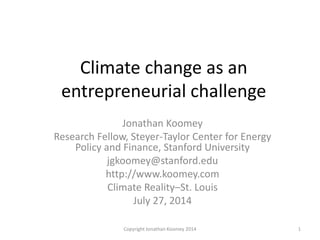



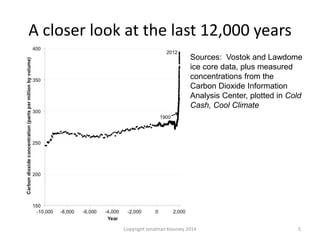
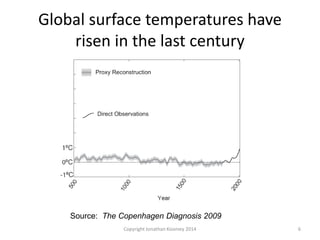
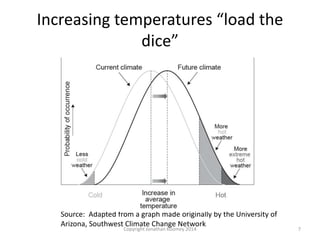

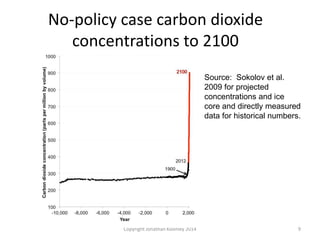
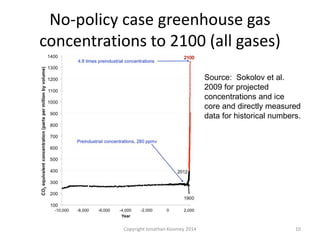



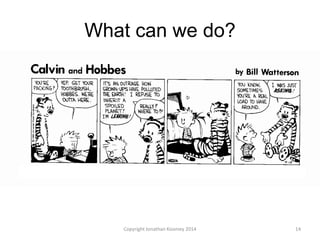








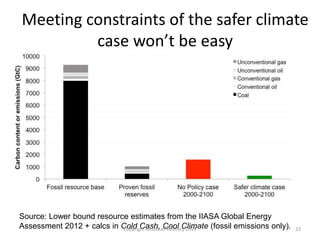
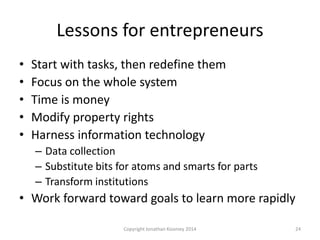




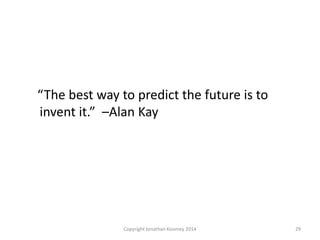
![References
• Allison, et al. 2009. The Copenhagen Diagnosis, 2009: Updating the World on the Latest Climate Science. Sydney, Australia: The
University of New South Wales Climate Change Research Centre (CCRC).
• Caldeira, Ken, Atul K. Jain, and Martin I. Hoffert. 2003. "Climate Sensitivity Uncertainty and the Need for Energy Without CO2 Emission
" Science. vol. 299, no. 5615. pp. 2052-2054. <http://www.sciencemag.org/cgi/content/abstract/299/5615/2052>
• DeCanio, Stephen J. 2003. Economic Models of Climate Change: A Critique. Basingstoke, UK: Palgrave-Macmillan.
• Brown, Marilyn A., Mark D. Levine, Walter Short, and Jonathan G. Koomey. 2001. "Scenarios for a Clean Energy Future." Energy
Policy (Also LBNL-48031). vol. 29, no. 14. November. pp. 1179-1196.
• Gritsevskyi, Andrii, and Nebojsa Nakicenovic. 2000. "Modeling uncertainty of induced technological change." Energy Policy. vol. 28, no.
13. November. pp. 907-921.
• Koomey, Jonathan. Testimony of Jonathan Koomey, Ph.D. for a hearing on "Efficiency: The Hidden Secret to Solving Our Energy
Crisis". Joint Economic Committee of the U.S. Congress. U.S. Congress. Washington, DC: U.S. Congress. July 30, 2008.
<http://www.jec.senate.gov/index.cfm?FuseAction=Hearings.HearingsCalendar&ContentRecord_id=6fc51d63-e7e2-82b7-10c3-
3faa2c150115>
• Koomey, Jonathan G., Stephen Berard, Marla Sanchez, and Henry Wong. 2011. "Implications of Historical Trends in The Electrical
Efficiency of Computing." IEEE Annals of the History of Computing. vol. 33, no. 3. July-September. pp. 46-54.
[http://doi.ieeecomputersociety.org/10.1109/MAHC.2010.28]
• Koomey, Jonathan G. Cold Cash, Cool Climate: Science-Based Advice for Ecological Entrepreneurs. Burlingame, CA: Analytics Press,
2012.
• Krause, Florentin, Wilfred Bach, and Jonathan G. Koomey. 1992. Energy Policy in the Greenhouse. NY, NY: John Wiley and Sons. (1989
edition of this book downloadable at <http://files.me.com/jgkoomey/9jzwgj>)
• Meinshausen, Malte, Nicolai Meinshausen, William Hare, Sarah C. B. Raper, Katja Frieler, Reto Knutti, David J. Frame, and Myles R.
Allen. 2009. "Greenhouse-gas emission targets for limiting global warming to 2 degrees C." Nature. vol. 458, April 30. pp. 1158-1162.
<http://www.nature.com/nature/journal/v458/n7242/full/nature08017.html>
• Pacala, S., and Rob Socolow. 2004. "Stabilization Wedges: Solving the Climate Problem for the Next 50 Years with Current Technologies
" Science. vol. 305, no. 5686. August 13. pp. 968-972. [http://www.sciencemag.org/cgi/content/abstract/305/5686/968]
• Williams, James H., Andrew DeBenedictis, Rebecca Ghanadan, Amber Mahone, Jack Moore, William R. Morrow, Snuller Price, and
Margaret S. Torn. 2011. "The Technology Path to Deep Greenhouse Gas Emissions Cuts by 2050: The Pivotal Role of
Electricity." Science. November 24. [http://www.sciencemag.org/content/early/2011/11/22/science.1208365.abstract]
30Copyright Jonathan Koomey 2014](https://image.slidesharecdn.com/koomeyonclimate-v7-140727220924-phpapp01/85/Climate-Change-as-an-Entrepreneurial-Challenge-A-virtual-talk-for-the-St-Louis-Climate-Reality-group-30-320.jpg)

